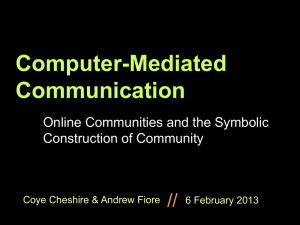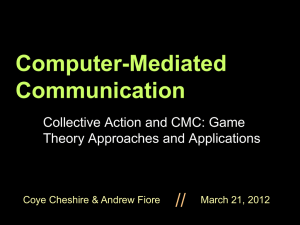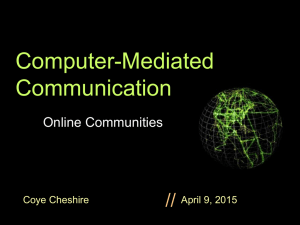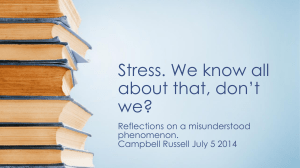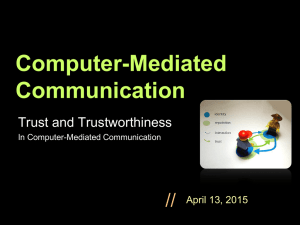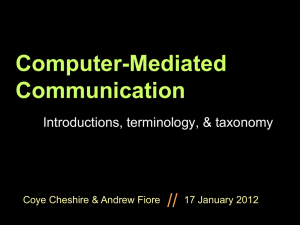slides - Courses
advertisement
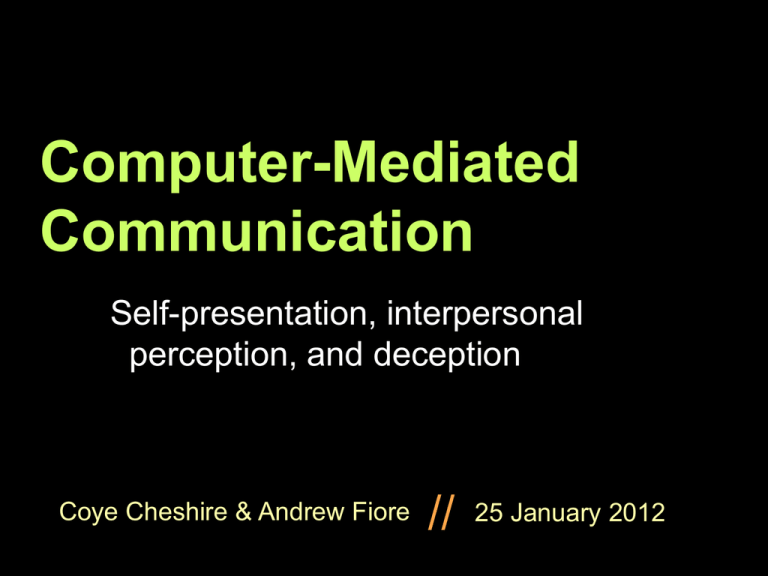
Computer-Mediated Communication Self-presentation, interpersonal perception, and deception Coye Cheshire & Andrew Fiore // 25 January 2012 The basic stuff: readings, website, etc… Office hours: 305A South Hall Wednesday 1:30 to 2:30 pm Course reader — for what’s not online At Copy Central (2560 Bancroft at Telegraph) Class mailing list (directions on course homepage) i216@ischool.berkeley.edu Web site — syllabus and readings (password) http://courses.ischool.berkeley.edu/i216/s12/ 1/25/12 Cheshire & Fiore — Computer-Mediated Communication 1 Weekly reviews Two short reviews required per week. “Short but informative.” Think of a good online review (Yelp, Amazon.com, etc.). A few paragraphs is sufficient. Be honest but be specific. Critique, explore, examine — no need to summarize. Due by 5pm every Tuesday. No Exceptions! Reviews are an important part of discussion. We will wrap them into our lectures and slides. 30% of your grade — can’t pass the class without them. Course password: ************ 1/25/12 Cheshire & Fiore — Computer-Mediated Communication 2 Mailing List: i216@ischool.berkeley.edu https://calmail.berkeley.edu/manage/list /listinfo/i216@ischool.berkeley.edu 1/25/12 Cheshire & Fiore — Computer-Mediated Communication 3 Identity: “Who am I?” Identity consists of personal identity + social identity Social identity often based on group affiliations Paradigm shift in conceptions of identity — Modern (Enlightenment through 20th century) Fixed, stable, unitary Post-Modern (now) Fluid, multiple, socially constructed Different roles in different settings: “One wakes up as a lover, makes breakfast as a mother, and drives to work as a lawyer.” — Sherry Turkle Different contexts make different aspects of our identity more salient: e.g., a classroom, party, church, or family dinner. 1/25/12 Cheshire & Fiore — Computer-Mediated Communication 4 Identity Theory (Sociology) Identity Theory (e.g., Stryker 1980) Individuals have “role identities”: character and the role an individual devises as an occupant of a particular social position. ‘Self’ is hierarchical ordering of identities by salience. The greater the commitment on an identity, the greater the salience of the identity. Salience of identity influences behavioral choices in a situation. 1/25/12 Cheshire & Fiore — Computer-Mediated Communication 5 When and where do you “activate” your identity? 1/25/12 Cheshire & Fiore — Computer-Mediated Communication 6 Social Identity Theory (Psychology) Social Identity Theory (e.g., Tajfel et al. 1981; Turner 1985) How group membership and “belongingness” have consequences for interpersonal and intergroup relations. As one looks for a positive sense of self, they compare their group with other groups and tend to create a favorable distinction for their own group 1/25/12 Photo credit: http://www.suntimes.com/sports/10176597-419/kyle-williamsfumbles-away-49ers-chance-at-super-bowl.html Cheshire & Fiore — Computer-Mediated Communication 7 “Minimal Group” Paradigm 1/25/12 Cheshire & Fiore — Computer-Mediated Communication 8 Identity and the internet Disembodiment: identity/soul/spirit separate from physical body CMC allows us to adopt identities independent from our bodies (and the markers they contain) Sherry Turkle (1995): “[On the Internet] you can be whoever you want to be. You can completely redefine yourself if you want. [People] don’t look at your body and make assumptions. They don’t hear your accent and make assumptions. All they see are your words.” 1/25/12 Cheshire & Fiore — Computer-Mediated Communication 9 Self-presentation and identity Symbolic markers express our identity to others — and help us make sense of it ourselves Signals of who we are (or want to be, or want people to think we are) Offline: clothes, hair, body modifications Online? Identity is socially constructed and informed by our relations with others — what they think of us, what we think of them, how we think of ourselves. 1/25/12 Cheshire & Fiore — Computer-Mediated Communication 10 A brief introduction to Symbolic Interaction “The character of interaction as it takes place between human beings.” Herbert Blumer (1900-1987) developed much of the sociological approach to SI Long history of development in both philosophy and sociology In essence: people act toward things based on the meaning those things have for them; and these meanings are derived from social interaction and modified through interpretation” 1/25/12 Cheshire & Fiore — Computer-Mediated Communication 11 Core Features of SI Symbols… Change… 1/25/12 Cheshire & Fiore — Computer-Mediated Communication 12 Core Features of SI Interaction… Empirical… 1/25/12 However: note the focus on the micro-level Cheshire & Fiore — Computer-Mediated Communication 13 Goffman’s approach and focus How individuals create and maintain their “social self” Dramaturgical approach: Uses theater and drama as a metaphor for how we develop and present ourselves 1/25/12 Cheshire & Fiore — Computer-Mediated Communication 14 http://media.knoxnews.com/media/img/photos/2010/08/11/090110bjheroleahy_t607.jpg 1/25/12 Cheshire & Fiore — Computer-Mediated Communication 15 Frontstage and backstage 1/25/12 Cheshire & Fiore — Computer-Mediated Communication 16 More key concepts from Goffman “Sincere” vs. “cynical” “Idealization” “Definition of the situation” “Expressions given” “Expressions given off” “Impression management” 1/25/12 Cheshire & Fiore — Computer-Mediated Communication 17 Expressions “given” and “given off” Goffman discusses two types of expressions: “given” (intentional) “given off” (unintentional) 1/25/12 Cheshire & Fiore — Computer-Mediated Communication 18 Group discussion Take a moment individually and think of one or two roles that you play in your life that you feel are core to your identity. Get together with your group to discuss: What aspects of these roles do you perform differently due to the qualities of the communication medium you’re using? Are some media better-suited for performing some roles? If so, why? Pick one or two roles from your group where the communication medium makes a difference in how it’s performed to share with the class. 1/25/12 Cheshire & Fiore — Computer-Mediated Communication 19 Social order through interaction? Goffman argues that social order can be an outcome of our symbolic interactions… What are some examples of how this “social order” might occur (in CMC or other ‘mediated’ situations)? 1/25/12 Cheshire & Fiore — Computer-Mediated Communication 20 What is the “setting” in CMC interaction? Where does it come from? 1/25/12 Cheshire & Fiore — Computer-Mediated Communication 21 “ The online world is a wholly built environment. The architects of a virtual space — from the software designers to the site administrators — shape the community in a more profound way than do their real-world counterpart. People eat, sleep, and work in buildings; the buildings affect how happily they do these things. But the buildings do not completely control their perception of the world. In the electronic domain, the design of the environment is everything. ” — Donath 1/25/12 Cheshire & Fiore — Computer-Mediated Communication 22 “The problem with 'The Presentation of Self in Everyday Life' and the use of it in the discussion of CMC and identity, is that his dramaturgical metaphors are manifested in analogue examples and not intended for being use online. This is evident when talking about backstage - at home with no physical presence of people – and this is most often where we are when commutating with other people online” -Morten “I wonder if sociologists like Goffman who write about basic human functions or interactions ever take a step back and wonder, as I often do, what exactly the value is that is being added. Do they question it?” -Monica 1/25/12 Cheshire & Fiore — Computer-Mediated Communication 23 Signaling Assessment signals Handicap (costly) signals Index signals Conventional signals Cost of signaling, cost of assessing What are some more examples of signals? At a bar, on IM, in online dating, on Facebook? 1/25/12 Cheshire & Fiore — Computer-Mediated Communication 24 Costs and benefits for sender Costs Production Risk Punishment Benefits Signaling: Changing observer’s beliefs Functional: Hedonic and utilitarian 1/25/12 Cheshire & Fiore — Computer-Mediated Communication 25 Costs and benefits for receiver Costs Assessment Being deceived by a dishonest signal Benefits Signaling: Learning about the sender Functional: Again, hedonic and utilitarian 1/25/12 Cheshire & Fiore — Computer-Mediated Communication 26 How does signaling differ online and offline? 1/25/12 Cheshire & Fiore — Computer-Mediated Communication 27 4/13/2015 Computer-Mediated Communication 28 Just for fun Passport to the Pub: A guide to British pub etiquette http://www.sirc.org/publik/pub.html Guide to Flirting http://www.sirc.org/publik/flirt.html Both from Social Issues Research Centre. 1/25/12 Cheshire & Fiore — Computer-Mediated Communication 29 1/25/12 Cheshire & Fiore — Computer-Mediated Communication 30 Deception 1/25/12 Cheshire & Fiore — Computer-Mediated Communication 31 Digital deception “The intentional control of information in a technologically mediated message to create a false belief in the receiver of the message.” Deliberate Designed to mislead or create a false belief Information communicated through technological mediation 1/25/12 Cheshire & Fiore — Computer-Mediated Communication 32 Identity…ambiguity vs. deception 1/25/12 Cheshire & Fiore — Computer-Mediated Communication 33 Expression and Interpretation Recall: Donath (1999) ties both voice and language to Erving Goffman’s concepts of “expressions given” and “expressions given off”: 4/13/2015 Computer-Mediated Communication 34 4/13/2015 Computer-Mediated Communication 35 For Example: Deception, Norms and Perception in Photos Lauren Session’s study of MySpace photos (2009) Users who post these photographs are conforming to a social trend at the expense of their individuality The presentation of these photographs is narcissistic These photographs purposefully conceal the body 4/13/2015 The classic “down shirt” MySpace photo. Computer-Mediated Communication 36 1/25/12 Cheshire & Fiore — Computer-Mediated Communication 37 Profile-based Self-Presentation Observed Self-Presentation In lab measure: •Height •Weight •Age •Income •Photograph Cross-Validation 1/25/12 Cheshire & Fiore — Computer-Mediated Communication 38 Deception? (Hancock et al. 2007) 1/25/12 Cheshire & Fiore — Computer-Mediated Communication 39 Deception? (Hancock et al. 2007) 1/25/12 Cheshire & Fiore — Computer-Mediated Communication 40 Deception? (Hancock et al. 2007) 1/25/12 Cheshire & Fiore — Computer-Mediated Communication 41 Types of digital deception Identity-based Stems from false manipulation of person or organization Message-based Takes place in communication between dyads or larger groups 1/25/12 Cheshire & Fiore — Computer-Mediated Communication 42 Identity-based deception Turkle pointed out that it’s easy to assume new identities online due to anonymity and multiple modes of social interaction. We use signals (screen names, language) to establish our identities online. It is relatively easy to manipulate these signals to falsely represent ourselves. Donath distinguishes between assessment and conventional signals Assessment signals are more expensive to maintain (harder to fake) 1/25/12 Cheshire & Fiore — Computer-Mediated Communication 43 Types of identity deception Trolling: posing as a legitimate community member Category deception: membership in a social group (male vs. female, black vs. white, Berkeley vs. Stanford student) Identity concealment: deception by omission or hiding of identity information 1/25/12 Cheshire & Fiore — Computer-Mediated Communication 44 1/25/12 Cheshire & Fiore — Computer-Mediated Communication 45 The Strange Case of the Electronic Lover Male psychiatrist, Alex, created female online persona, Joan. Formed intimate online friendships with women on CompuServe chat channels. Initiated real-life romantic relationship with one of them (Alex “introduced” by Joan). Is this right or wrong? A legitimate or illegitimate use of CMC? 1/25/12 Cheshire & Fiore — Computer-Mediated Communication 46 The Deception in the Message… 4/13/2015 Computer-Mediated Communication 47 How is deception different online and offline? 4/13/2015 Computer-Mediated Communication 48 Think of lie you told today or yesterday. What medium did it take place in? 1/25/12 Cheshire & Fiore — Computer-Mediated Communication 49 Lying in different communication media In which medium will we lie most? 1. FtF interaction 2. Phone 3. Instant Messaging 4. Email Why? 1/25/12 Cheshire & Fiore — Computer-Mediated Communication 50 Examining deceptive behavior Participants recorded social interactions and lies for 7 days with the Social Interaction & Lie form Each social interaction (greater than 10 min) Which medium (FtF, phone, IM, email, chat, etc.) Whether or not they lied 1/25/12 Cheshire & Fiore — Computer-Mediated Communication 51 Results — Hancock et al. % of interactions involving a lie 37% 27% 21% 14% FtF 1/25/12 Phone Instant Email Message Cheshire & Fiore — Computer-Mediated Communication 52 Feature-based approach Media features FtF Phone IM Synchronous X X X* Recordless X X X* X X X Distributed (not copresent) Email Lying predictions Feature-based 2 1 2 3 Media Richness 1 2 3 4 Social Distance 4 3 2 1 * Usually 1/25/12 Cheshire & Fiore — Computer-Mediated Communication 53 Predictions based on features The more recordable the medium (papertrail), the less likely people are to lie. The more synchronous and distributed (but not recordable), the more lying will occur: Phone FtF IM Email Others? 1/25/12 most least Cheshire & Fiore — Computer-Mediated Communication 54 “It was surprising to me that a diary study about the mediums of deception found that participants lied most frequently on the phone. I would've thought that lying in emails, chat, or other forms of indirect communication where the two people can neither hear nor see each other is much more common than on the phone or face-to-face” - Wei “I don't agree that deception in person is as straightforward as he claims. While there are visual cues, body language and the ability to infer from your interaction, being able to judge deception F2F can be just as complex if there is no prior relationship or history with the other person” - Kristine 1/25/12 Cheshire & Fiore — Computer-Mediated Communication 55 Deception as an aspect of “Media Richness” Media ‘richness’ is only a singular dimension that may mask the complexity of choice, behavior and inference of purpose. Image: Time Barrow Dissertation Research, http://blog.timebarrow.com/2009/09/media-richness-theory/ 1/25/12 Cheshire & Fiore — Computer-Mediated Communication 56 Other Dimensions: Synchronicity Recordability Distribution of Speaker/Listener 1/25/12 Cheshire & Fiore — Computer-Mediated Communication 57 What about the content of lies? Another Hancock et al. diary study: More lies about feelings in synchronous interaction (because feelings are more likely to come up) More lies about explanations in asynchronous media (more time to plan and construct) More lies about actions on the telephone (where people can’t see what you’re doing) No difference across media in lies about facts (might have expected more in recordless media) 1/25/12 Cheshire & Fiore — Computer-Mediated Communication 58 Do we use language differently when we lie? In asynchronous, text-based interaction: Liars used more words, were more expressive, non-immediate and informal, and made more typos (Zhou et al. 2004). Similar in synchronous IM interaction: More words and fewer self-references Those lied to also IMed differently, even when they didn’t realize the deceit: Shorter sentences, more questions. 1/25/12 Cheshire & Fiore — Computer-Mediated Communication 59 Detecting deception Most people (even trained professionals, like police officers) detect deception at no better than a chance rate Some reliable markers of lying: Illustrative and other body movements, higher pitch, microexpressions: http://www.youtube.com/watch?v=EXm6YbXxSYk These are hard to detect online, esp. in text People highly motivated to lie may be easier to detect (i.e., trying harder may give you away) — “motivation impairment effect” 1/25/12 Cheshire & Fiore — Computer-Mediated Communication 60 Detecting deception No consistent findings about whether certain media make it easier or harder to detect deception In some studies, it’s easier in richer media; in others, in leaner media or no difference. However, the motivation impairment effect may be lessened in CMC — less is “given off”: Hancock et al. (2005): Motivated liars detected more often than unmotivated ones in FtF, but less often in CMC. Motivated CMC liars least detected of all. 1/25/12 Cheshire & Fiore — Computer-Mediated Communication 61 For next Wednesday… Community, Online and Offline Cohen, A.P. (1985) Chapters 1 and 3 from The Symbolic Construction of Community. London: Routledge. (In reader.) Haythornthwaite, C. (2007) Social networks and online community. In Joinson, A., McKenna, K., Postmes, T., and U-D. Reips (Eds.) The Oxford Handbook of Internet Psychology. Oxford, England: Oxford University Press. (In reader.) McKenna, K.Y.A. (2008) Influences on the nature and functioning of online groups. In A. Barak (Ed.), Psychological aspects of cyberspace: Theory, research, applications. Cambridge, UK: Cambridge University Press. Remember to write your reviews! 1/25/12 Cheshire & Fiore — Computer-Mediated Communication 62
